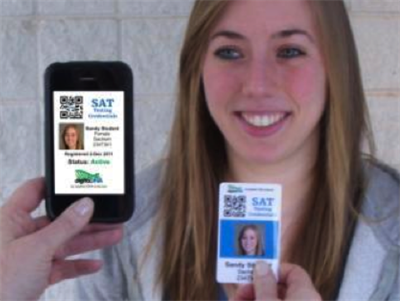Digital DNA Takes On SAT Exam Cheating

As New York lawmakers consider a bill that would make cheating on the SAT a felony, one company thinks it has the answer to thwarting testing fraud: the “digitalDNA™ ID.”
Residents of New York State, and Long Island in particular, were in shock last November when dozens of students were arrested, accused of paying up to thousands of dollars each to have others take the all-important SAT college entrance exam for them.
"It was easy," one of the suddenly-rolling-in-dough test takers put it. "The IDs were school IDs. What is that? I just pasted my own picture into the ID and got in." The news galvanized lawmakers, who pledged to come up with cutting-edge ways to combat identity theft.
As New York lawmakers consider a bill that would make cheating on the SAT a felony, one company thinks it has the answer to thwarting testing fraud: the “digitalDNA™ ID.” No, it’s not the students’ DNA, if that’s what you are thinking—but the system does use plant DNA to encode ID information on the card. In addition, the card is stamped with a visible code called digitalDNA™. The plant DNA is verified in a lab if necessary, but most of the time, the visible “ digitalDNA” code is scanned, using an iPhone with a proprietary app.
Dr. James Hayward, president and CEO of Long Island-based Applied DNA Sciences, Inc., said the "absolutely unbreakable" system features a counterfeit-proof identification card that uses segments of plant DNA to help authenticate a student's identity.
"This is a very affordable approach and it's one we think will become widespread as a consequence," he said. "And the beauty of DNA is that it would elevate any rapid screening to a forensic-level identification method that would [be upheld] in court."
Dr. Hayward presented the technology during a recent hearing before the New York Senate Higher Education Committee. He said Applied DNA, a public company that is affiliated with Stony Brook University's Center for Excellence in Wireless & Information Technology, is now in early discussions with officials at the Educational Testing Service (ETS) and The College Board, which administer the SAT.
On test day, the student presents the digitalDNA™ entry ID. The following then occurs:
- Code is scanned
- Identity data is retrieved from cloud
- 3-point identity comparison is conducted—student, database, ID card
Student can enter testing area only once - Time and location recorded
“Roaming” students are quickly identified
For added security, a DNA-marked, fluorescing image is imprinted on the back of the card. The digitalDNA code is protected with a DNA marker. The cost of the program would be "pennies per card," Hayward said, and would ultimately be based on the number of authentications used by school officials.
"Botanical DNA markers transform SAT identification cards into robust evidentiary tools that can assist in criminal prosecution efforts,” Dr. Hayward continued. “The challenge is to ensure that actual, eligible, registered participants complete their exams. We are confident that digitalDNA can assist in achieving the goal of an effective, easy-to-use and affordable system for preventing testing fraud.
“The goal is preserving exam integrity and maintaining a level playing field for all participants, and the solution is enhanced preregistration in tandem with identity verification before and after exams,” he added.
To learn more, go to www.adnas.com.
About Applied DNA Sciences, Inc.
Applied DNA Sciences, Inc. sells patent-protected DNA security solutions to protect products, brands and intellectual property from counterfeiting and diversion. SigNature DNA is a botanical mark used to authenticate products in a unique manner that essentially cannot be copied, and provide a forensic chain of evidence that can be used to prosecute perpetrators. To learn more, go to www.adnas.com where APDN routinely posts all press releases.
Janet Vasquez, Director of Corporate Communications
The Investor Relations Group
11 Stone Street, 3rd floor
New York, NY 10004
212-825-3210
jvasquez@Investorrelationsgroup.com
Tags:

